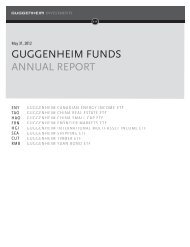Guggenheim Credit Allocation Fund GGM - Guggenheim Investments
Guggenheim Credit Allocation Fund GGM - Guggenheim Investments
Guggenheim Credit Allocation Fund GGM - Guggenheim Investments
- No tags were found...
You also want an ePaper? Increase the reach of your titles
YUMPU automatically turns print PDFs into web optimized ePapers that Google loves.
Emerging markets risk<strong>Investments</strong> in securities the issuers of which are located in countries considered to be emerging markets aresubject to heightened risks relative to foreign investing generally and are considered speculative. Investing inemerging markets involves certain heightened risks associated with: smaller market capitalization of securitiesmarkets, which may suffer periods of relative illiquidity; significant price volatility; restrictions on foreigninvestment; and potential restrictions on repatriation of investment income and capital. See “Risks—EmergingMarkets Risk.”Foreign currency riskThe <strong>Fund</strong>’s investment performance may be negatively affected by a devaluation of a currency in which the<strong>Fund</strong>’s investments are denominated or quoted. Further, the <strong>Fund</strong>’s investment performance may besignificantly affected, either positively or negatively, by currency exchange rates because the U.S. dollar valueof securities denominated or quoted in another currency will increase or decrease in response to changes in thevalue of such currency in relation to the U.S. dollar. See “Risks—Foreign Currency Risk.”Financial Leverage riskThe <strong>Fund</strong> initially expects to employ Financial Leverage through the issuance of Indebtedness and/or the use ofreverse repurchase agreements. The Adviser anticipates that the use of Financial Leverage may result in higherincome to Common Shareholders over time; however, there can be no assurance that the Adviser’s expectationswill be realized or that a leveraging strategy will be successful in any particular time period. Use of FinancialLeverage creates an opportunity for increased income and capital appreciation but, at the same time, createsspecial risks. Leverage is a speculative technique that exposes the <strong>Fund</strong> to greater risk and increased costs thanif it were not implemented. There can be no assurance that a leveraging strategy will be utilized or will besuccessful.The use of leverage by the <strong>Fund</strong> will cause the net asset value, and possibly the market price, of the <strong>Fund</strong>’sCommon Shares to fluctuate significantly in response to changes in interest rates and other economic indicators.As a result, the net asset value and market price and dividend rate of the Common Shares of the <strong>Fund</strong> is likelyto be more volatile than those of a closed-end management investment company that is not exposed to leverage.In a declining market, the use of leverage may result in a greater decline in the net asset value of the CommonShares than if the <strong>Fund</strong> were not leveraged.Financial Leverage will increase operating costs, which may reduce total return. The <strong>Fund</strong> will have to payinterest on its Indebtedness, if any, which may reduce the <strong>Fund</strong>’s return. This interest expense may be greaterthan the <strong>Fund</strong>’s return on the underlying investment. Increases in interest rates that the <strong>Fund</strong> must pay on itsIndebtedness will increase the cost of leverage and may reduce the return to Common Shareholders. This riskmay be greater in the current market environment because interest rates are near historically low levels.Certain types of Indebtedness subject the <strong>Fund</strong> to covenants in credit agreements relating to asset coverageand portfolio composition requirements. Certain Indebtedness issued by the <strong>Fund</strong> also may subject the <strong>Fund</strong>to certain restrictions on investments imposed by guidelines of one or more rating agencies, which may issueratings for such Indebtedness. Such guidelines may impose asset coverage or portfolio compositionrequirements that are more stringent than those imposed by the 1940 Act. It is not anticipated that thesecovenants or guidelines will impede the Adviser from managing the <strong>Fund</strong>’s portfolio in accordance with the<strong>Fund</strong>’s investment objective and policies.Reverse repurchase agreements involve the risks that the interest income earned on the investment of theproceeds will be less than the interest expense and <strong>Fund</strong> expenses associated with the repurchase agreement,that the market value of the securities sold by the <strong>Fund</strong> may decline below the price at which the <strong>Fund</strong> isobligated to repurchase such securities and that the securities may not be returned to the <strong>Fund</strong>. There is noassurance that reverse repurchase agreements can be successfully employed. Dollar roll transactions involve therisk that the market value of the securities the <strong>Fund</strong> is required to purchase may decline below the agreed uponrepurchase price of those securities. Successful use of dollar rolls may depend upon the Adviser’s ability to15



